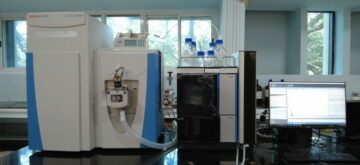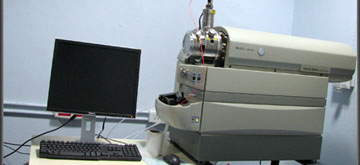Q Exactive Ultra High Mass range (UHMR) Hybrid Quadrupole-Orbitrap mass spectrometer

Instrument specification
The Thermo Scientific Q Exactive UHMR hybrid Quadrupole-Orbitrap mass spectrometer combines in-source trapping, high-performance quadrupole precursor ion selection, a higher-energy collisional dissociation (HCD) cell, and a high-resolution, accurate-mass (HRAM) Orbitrap mass analyzer, with optimized RF voltages for improved high mass ion transmission to provide unrivaled sensitivity and resolution in the ultra-high mass range.
Technicalities
- Ultra-high mass range up to m/z 80,000.
- Quadrupole isolation up to m/z 25,000 for Selected Ion Monitoring (SIM), MS/MS and pseudo-MS3 experiments.
- Resolution up to 200,000 (FWHM) at m/z 400.
- In-source trapping for higher transmission and better desolvation.
- Advanced Quadrupole Technology (AQT) for superior precursor isolation.
- Advanced Active Beam Guide (AABG) for greater sensitivity and maximum robustness.
Operation modes
- Full MS with high resolution, accurate mass detection
- SIM with high resolution, accurate mass detection
- All Ion Fragmentation (AIF) using in-source CID, in-source trapping or HCD
- MS/MS and pseudo-MS3 of isolated ions with high-resolution, accurate mass detection
Schematic of the Q Exactive UHMR

Theory of operation
The Q Exactive UHMR mass spectrometer provides the ability to perform pseudo-MS3 for native top-down analysis and transmission of very high m/z ions through the implementation of both hardware and software enhancements. The most important of these enhancements were pulsed trapping of ions in the injection flatapole region, a process called “in-source trapping,” for the reduction of the frequency of RF voltages applied to the injection and bent flatapoles, quadrupole, transfer multipole, C-trap, and HCD cell. In-source trapping allows controllable, and highly efficient desolvation of large ions, and also the optional application of energy to dissociate these ions into subunits in the injection flatapole region prior to their release for subsequent mass analysis, including pseudo-MS3 analysis. The reduced RF voltages increase the efficiency of high m/z ion transfer and utilization, delivering high sensitivity, with low sample volume requirements. Multiple charged ions are detected with such efficiency that individual ions can be detected within milliseconds, providing the ultimate analytical sensitivity needed for minute sample volumes. Other developments include gas pressure control, an increase in the maximum HCD energy from 200 to 300 V, and an adjustment of the voltage ramp rate of the Orbitrap mass analyzer, which facilitates transmission of very high m/z ions from the C-trap into the Orbitrap mass analyzer.
 Search
Search Sign in
Sign in








 Total views : 237771
Total views : 237771